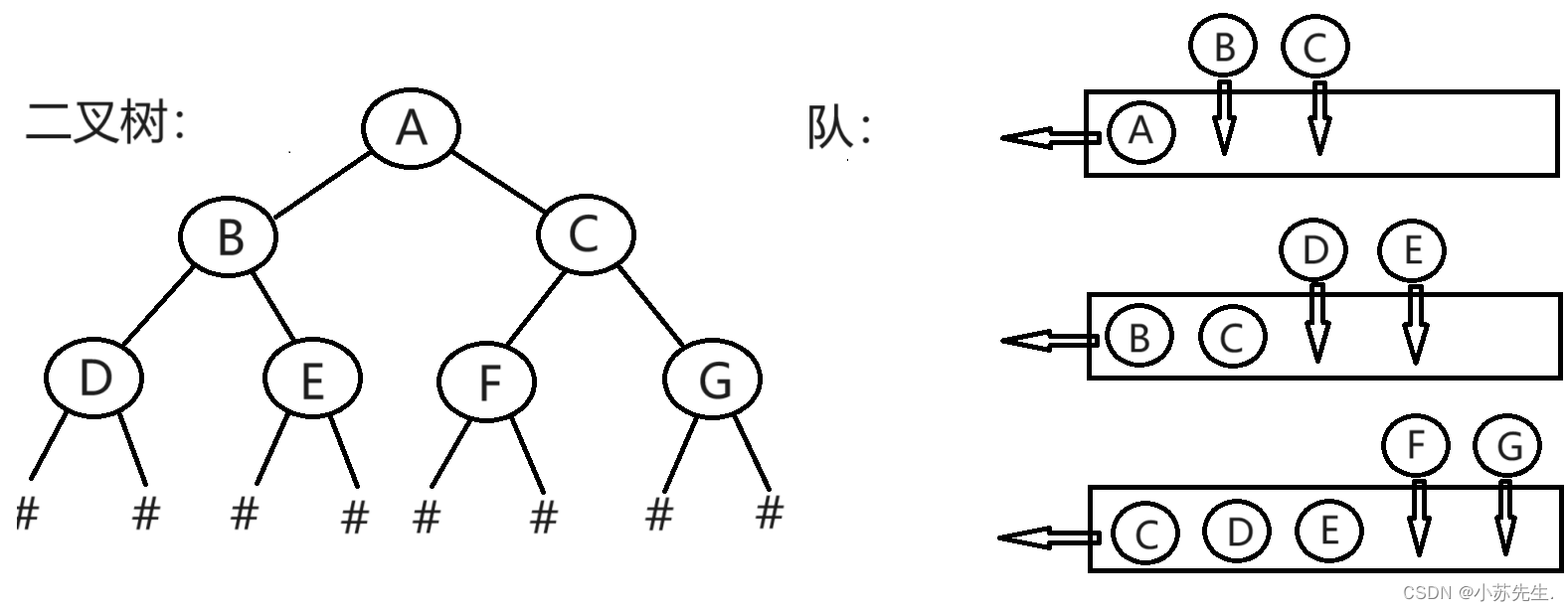c语言二叉树的层次遍历(超详细)学习笔记
?前言:
我学习数据结构的方式是看书加看视频,视频看的是哔哩哔哩up主的 二叉树的层次遍历?我总结并补充他所讲的内容,他的视频适合有c语言基础的看。本文章继我的上一篇文章??c语言二叉树的创建与前序、中序、后序遍历(超详细)学习笔记?,在二叉树的前序、中序、后序的三种遍历上,继续详细解释二叉树的层次遍历。看完此片文章,一定会有所收获的!
思路:
若想实现层次遍历,那么应该是先遍历根节点A,然后遍历它的左子树B,再遍历它的右子树C,再遍历B的左子树,再遍历B的右子树...
按照这个逻辑关系,我们可以运用树+队的形式,树的结点作为队的元素。
每次入队一个树结点,进行遍历,出队,然后再在将这个树结点的左孩子和右孩子进行入队,依次进行...最终得到层次遍历:A B C D E F G

一、创建树结构体
//创建树结构体
typedef struct TreeNode
{
char data;
struct TreeNode* lChild;
struct TreeNode* rChild;
}treeNode;二、创建循环队列结构体(链式存储方式)
循环队列的解释:
队的特点是先进先出,循环队列适应两种存储结构,顺序存储有队满情况,链式存储不存在队满情况。因为是链式存储方式,所以不能通过顺序存储中的real和front来判断队空,通过链式结构中的指针域来联系队中的元素彼此。
那么就有两种循环方式:单循环队列和双循环队列方式。所以我会展示两种方式。当然两种方法各有所爱了,总体上是差不多的。
(1)创建单循环队列
//创建循环队列结构体
typedef struct QueueNode
{
treeNode* data;树的结点作为元素
struct QueueNode* next;
}QueueNode;(2)创建双循环队列
//创建双循环队列结构体
typedef struct QueueNode
{
treeNode* data; //树的结点作为元素
struct QueueNode* next;
struct QueueNode* pre;
}QueueNode;三、初始化二叉树
仍是使用先序方式进行传入数据 并运用递归。如果想了解递归详细的推导,可以看看我的这篇文章?c语言二叉树的创建与前序、中序、后序遍历(超详细)学习笔记
//初始化二叉树
TreeNode* creatTree()
{
TreeNode* T;
char ch;
scanf_s("%c", &ch);//通过输入的ch是否是‘#’来判断该节点是否有孩子节点
if (ch == '#') //'#'代表传入的是空结点
{
//此时为空结点
return NULL;
}
else
{
//不为空
T = (TreeNode*)malloc(sizeof(TreeNode));
T->data = ch;
//创建左子树,逻辑一致,进行递归
T->lChild = creatTree();
//创建右子树,逻辑一致,进行递归
T->rChild = creatTree();
return T;
}
}四、创建空队
(1)单循环队列:
//创建空队
QueueNode* initQueue()
{
QueueNode* Q = (QueueNode*)malloc(sizeof(QueueNode));
Q->data = NULL;
Q->next = Q;
return Q;
}(2)双循环队列:
//创建空队
QueueNode* initQueue()
{
QueueNode* Q = (QueueNode*)malloc(sizeof(QueueNode));
Q->data = NULL;
Q->next = Q;
Q->pre = Q;
return Q;
}五、入队? (尾插法入队)
尾插法入队的解释:先进先出,方便出队时快速找到当前元素,Q->next == 出队的元素?
如:按照1,2,3,4,5的顺序入队,那么出队的顺序为1,2,3,4,5
头插法入队:Q->1->2->3->4->5,若想出队1,需找到元素1 即:Q->nest == 1,非常快速。
(1)单循环队列:
//入队 尾插法
void enQueue(QueueNode* Q, treeNode* data)
{
QueueNode* node = (QueueNode*)malloc(sizeof(QueueNode));
QueueNode* q = Q->next;
while(q->next != Q)
{
q = q->next;
}
node->data = data;
q->next = node;
node->next = Q;
}(2)双循环队列:
//入队 尾插法
void enQueue(QueueNode* Q, treeNode* data)
{
QueueNode* node = (QueueNode*)malloc(sizeof(QueueNode));
node->data = data;
node->pre = Q->pre;
node->next = Q;
Q->pre->next = node;
Q->pre = node;
}六、判断队是否为空
//判断队是否为空
int isEmpty(QueueNode* Q)
{
if (Q->next == Q)
{
return 1;
}
else
{
return 0;
}
}七、出队? (头插法出队)
头插法出队,非常快速的找到需要出队的元素,Q->next == 出队的元素
找到出队元素,进行出队操作并返回其元素。
(1)单循环队列:
//出队 头插法
treeNode* deQueue(QueueNode* Q)
{
if (isEmpty(Q))
{
return NULL;
}
else
{
QueueNode* node = Q->next;
treeNode* T = node->data;
Q->next = node->next;
free(node);
return T;
}
}(2)双循环队列:
//出队 头插法
treeNode* deQueue(QueueNode* Q)
{
if (isEmpty(Q))
{
return NULL;
}
else
{
QueueNode* node = Q->next;
treeNode* T = node->data;
Q->next = node->next;
node->next->pre = Q;
free(node);
return T;
}
}八、层次遍历
//层次遍历
void levelTraverse(QueueNode* Q, treeNode* T)
{
//先进队
enQueue(Q, T);
while (!isEmpty(Q))
{
treeNode* node = deQueue(Q);
//将node 进行遍历
printf("%c ", node->data);
//如果有左孩子
if (node->lChild)
{
enQueue(Q, node->lChild);
}
//如果有右孩子
if (node->rChild)
{
enQueue(Q, node->rChild);
}
}
}思路:每次入队一个树结点,出队并取出其元素,进行遍历,然后再在将这个树结点的左孩子和右孩子进行入队,依次进行...最终得到层次遍历:A B C D E F G

九、前序遍历
//前序遍历 根 左 右
void preOrder(treeNode* T)
{
if (T == NULL)
{
return;
}
else
{ //先办事
printf("%c ", T->data);
//左孩子
preOrder(T->lChild);
//右孩子
preOrder(T->rChild);
}
}十、完整代码
(1)单循环队列完整代码:
#include<stdio.h>
#include<stdlib.h>
//创建树结构体
typedef struct TreeNode
{
char data;
struct TreeNode* lChild;
struct TreeNode* rChild;
}treeNode;
//创建循环队列结构体
typedef struct QueueNode
{
treeNode* data;树的结点作为元素
struct QueueNode* next;
}QueueNode;
//初始化二叉树
TreeNode* creatTree()
{
TreeNode* T;
char ch;
scanf_s("%c", &ch);//通过输入的ch是否是‘#’来判断该节点是否有孩子节点
if (ch == '#') //'#'代表传入的是空结点
{
//此时为空结点
return NULL;
}
else
{
//不为空
T = (TreeNode*)malloc(sizeof(TreeNode));
T->data = ch;
//创建左子树,逻辑一致,进行递归
T->lChild = creatTree();
//创建右子树,逻辑一致,进行递归
T->rChild = creatTree();
return T;
}
}
//创建空队
QueueNode* initQueue()
{
QueueNode* Q = (QueueNode*)malloc(sizeof(QueueNode));
Q->data = NULL;
Q->next = Q;
return Q;
}
//入队 尾插法
void enQueue(QueueNode* Q, treeNode* data)
{
QueueNode* node = (QueueNode*)malloc(sizeof(QueueNode));
QueueNode* q = Q->next;
while(q->next != Q)
{
q = q->next;
}
node->data = data;
q->next = node;
node->next = Q;
}
//判断队是否为空
int isEmpty(QueueNode* Q)
{
if (Q->next == Q)
{
return 1;
}
else
{
return 0;
}
}
//出队 头插法
treeNode* deQueue(QueueNode* Q)
{
if (isEmpty(Q))
{
return NULL;
}
else
{
QueueNode* node = Q->next;
treeNode* T = node->data;
Q->next = node->next;
free(node);
return T;
}
}
//层次遍历
void levelTraverse(QueueNode* Q, treeNode* T)
{
//先进队
enQueue(Q, T);
while (!isEmpty(Q))
{
treeNode* node = deQueue(Q);
//将node 进行打印
printf("%c ", node->data);
//如果有左孩子
if (node->lChild)
{
enQueue(Q, node->lChild);
}
//如果有右孩子
if (node->rChild)
{
enQueue(Q, node->rChild);
}
}
}
//前序遍历 根 左 右
void preOrder(treeNode* T)
{
if (T == NULL)
{
return;
}
else
{ //先办事
printf("%c ", T->data);
//左孩子
preOrder(T->lChild);
//右孩子
preOrder(T->rChild);
}
}
int main()
{
QueueNode* Q = initQueue();
treeNode* T = creatTree();
printf("前序遍历:\n");
preOrder(T);
printf("\n");
printf("层次遍历:\n");
levelTraverse(Q, T);
printf("\n");
return 0;
}(2)双循环队列完整代码:
#include<stdio.h>
#include<stdlib.h>
//创建树结构体
typedef struct TreeNode
{
char data;
struct TreeNode* lChild;
struct TreeNode* rChild;
}treeNode;
//创建双循环队列结构体
typedef struct QueueNode
{
treeNode* data; //树的结点作为元素
struct QueueNode* next;
struct QueueNode* pre;
}QueueNode;
//初始化二叉树
TreeNode* creatTree()
{
TreeNode* T;
char ch;
scanf_s("%c", &ch);//通过输入的ch是否是‘#’来判断该节点是否有孩子节点
if (ch == '#') //'#'代表传入的是空结点
{
//此时为空结点
return NULL;
}
else
{
//不为空
T = (TreeNode*)malloc(sizeof(TreeNode));
T->data = ch;
//创建左子树,逻辑一致,进行递归
T->lChild = creatTree();
//创建右子树,逻辑一致,进行递归
T->rChild = creatTree();
return T;
}
}
//创建空队
QueueNode* initQueue()
{
QueueNode* Q = (QueueNode*)malloc(sizeof(QueueNode));
Q->data = NULL;
Q->next = Q;
Q->pre = Q;
return Q;
}
//入队 尾插法
void enQueue(QueueNode* Q, treeNode* data)
{
QueueNode* node = (QueueNode*)malloc(sizeof(QueueNode));
node->data = data;
node->pre = Q->pre;
node->next = Q;
Q->pre->next = node;
Q->pre = node;
}
//判断队是否为空
int isEmpty(QueueNode* Q)
{
if (Q->next == Q)
{
return 1;
}
else
{
return 0;
}
}
//出队 头插法
treeNode* deQueue(QueueNode* Q)
{
if (isEmpty(Q))
{
return NULL;
}
else
{
QueueNode* node = Q->next;
treeNode* T = node->data;
Q->next = node->next;
node->next->pre = Q;
free(node);
return T;
}
}
//层次遍历
void levelTraverse(QueueNode* Q, treeNode* T)
{
//先进队
enQueue(Q, T);
while (!isEmpty(Q))
{
treeNode* node = deQueue(Q);
//将node 进行遍历
printf("%c ", node->data);
//如果有左孩子
if (node->lChild)
{
enQueue(Q, node->lChild);
}
//如果有右孩子
if (node->rChild)
{
enQueue(Q, node->rChild);
}
}
}
//前序遍历 根 左 右
void preOrder(treeNode* T)
{
if (T == NULL)
{
return;
}
else
{ //先办事
printf("%c ", T->data);
//左孩子
preOrder(T->lChild);
//右孩子
preOrder(T->rChild);
}
}
int main()
{
int index = 0;
QueueNode* Q = initQueue();
treeNode* T = creatTree();
printf("前序遍历:");
preOrder(T);
printf("\n");
printf("层次遍历:");
levelTraverse(Q, T);
printf("\n");
return 0;
}十一、运行结果

输入:ABD##E##CF##G##
 ?
?
总结:
二叉树层次遍历的好处包括:
1.按照层级顺序访问节点:层次遍历可以按照树的层级顺序访问节点,从根节点开始,逐层向下遍历,这样可以更加直观地观察和理解整个二叉树的结构。
2.方便实现广度优先搜索:层次遍历是广度优先搜索(BFS)的一种实现方式。BFS是一种重要的图搜索算法,广泛应用于图的遍历、路径搜索、连通性判断等问题中。层次遍历的结果正好可以按照广度优先搜索的顺序得到。
3.快速查找某一层的节点:对于二叉树层次遍历的结果,每一层的节点都是按照从左到右的顺序排列的。因此,可以直接通过索引或下标的方式快速查找到某一层的节点。这种特性在某些问题中非常有用,比如在二叉树的每一层中查找特定的节点或值。
4.方便处理与层次相关的问题:有些问题与二叉树的层次相关,比如计算二叉树的最大深度、最小深度,判断二叉树是否是完全二叉树等等。通过层次遍历,可以轻松地处理与层次相关的问题,因为遍历的结果已经按照层级顺序排列好了。
总之,二叉树层次遍历可以提供对二叉树结构的直观理解,方便实现广度优先搜索,快速查找某一层的节点,并处理与层次相关的问题。
实现二叉树的层次遍历需要树+队的结合,队是循环队列,那么有单循环队列和双循环队列两种方式进行实现。制作不易,真心想让你懂,还是有不足的地方,望见谅嘞。
本文来自互联网用户投稿,该文观点仅代表作者本人,不代表本站立场。本站仅提供信息存储空间服务,不拥有所有权,不承担相关法律责任。 如若内容造成侵权/违法违规/事实不符,请联系我的编程经验分享网邮箱:veading@qq.com进行投诉反馈,一经查实,立即删除!